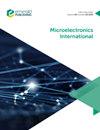Influence of extended surface area of heatsink on heat transfer: design and analysis
IF 0.8
4区 工程技术
Q4 ENGINEERING, ELECTRICAL & ELECTRONIC
引用次数: 0
Abstract
Purpose Light emitting diode (LED) has been the best resource for commercial and industrial lighting applications. However, thermal management in high power LEDs is a major challenge in which the thermal resistance (Rth) and rise in junction temperature (TJ) are critical parameters. The purpose of this work is to evaluate the Rth and Tj of the LED attached with the modified heat transfer area of the heatsink to improve thermal management. Design/methodology/approach This paper deals with the design of metal substrate for heatsink applications where the surface area of the heatsink is modified. Numerical simulation on heat distribution proved the influence of the design aspects and surface area of heatsink. Findings TJ was low for outward step design when compared to flat heatsink design (ΔT ∼ 38°C) because of increase in surface area from 1,550 mm2 (flat) to 3,076 mm2 (outward step). On comparison with inward step geometry, the TJ value was low for outward step configuration (ΔTJ ∼ 6.6°C), which is because of efficient heat transfer mechanism with outward step design. The observed results showed that outward step design performs well for LED testing by reducing both Rth and TJ for different driving currents. Originality/value This work is authors’ own design and also has the originality for the targeted application. To the best of the authors’ knowledge, the proposed design has not been tried before in the electronic or LED applications.散热器扩展表面积对传热的影响:设计与分析
发光二极管(LED)已成为商业和工业照明应用的最佳资源。然而,高功率led的热管理是一个主要挑战,其中热阻(Rth)和结温上升(TJ)是关键参数。本工作的目的是评估与改进散热器的传热面积连接的LED的Rth和Tj,以改善热管理。设计/方法/方法本文讨论了用于散热器应用的金属基板的设计,其中修改了散热器的表面积。对热分布的数值模拟证明了设计方面和散热器表面积的影响。与平面散热器设计(ΔT ~ 38°C)相比,外台阶设计的stj较低,因为表面积从1,550 mm2(平面)增加到3,076 mm2(外台阶)。与内台阶结构相比,外台阶结构的TJ值较低(ΔTJ ~ 6.6°C),这是因为外台阶设计具有有效的传热机制。观察结果表明,在不同的驱动电流下,外移阶设计可以降低Rth和TJ,可以很好地用于LED测试。原创性/价值本作品是作者自己的设计,也具有针对性应用的原创性。据作者所知,所提出的设计尚未在电子或LED应用中进行过尝试。
本文章由计算机程序翻译,如有差异,请以英文原文为准。
求助全文
约1分钟内获得全文
求助全文
来源期刊

Microelectronics International
工程技术-材料科学:综合
CiteScore
1.90
自引率
9.10%
发文量
28
审稿时长
>12 weeks
期刊介绍:
Microelectronics International provides an authoritative, international and independent forum for the critical evaluation and dissemination of research and development, applications, processes and current practices relating to advanced packaging, micro-circuit engineering, interconnection, semiconductor technology and systems engineering. It represents a current, comprehensive and practical information tool. The Editor, Dr John Atkinson, welcomes contributions to the journal including technical papers, research papers, case studies and review papers for publication. Please view the Author Guidelines for further details.
Microelectronics International comprises a multi-disciplinary study of the key technologies and related issues associated with the design, manufacture, assembly and various applications of miniaturized electronic devices and advanced packages. Among the broad range of topics covered are:
• Advanced packaging
• Ceramics
• Chip attachment
• Chip on board (COB)
• Chip scale packaging
• Flexible substrates
• MEMS
• Micro-circuit technology
• Microelectronic materials
• Multichip modules (MCMs)
• Organic/polymer electronics
• Printed electronics
• Semiconductor technology
• Solid state sensors
• Thermal management
• Thick/thin film technology
• Wafer scale processing.
 求助内容:
求助内容: 应助结果提醒方式:
应助结果提醒方式:


